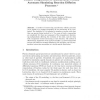Free Online Productivity Tools
i2Speak
i2Symbol
i2OCR
iTex2Img
iWeb2Print
iWeb2Shot
i2Type
iPdf2Split
iPdf2Merge
i2Bopomofo
i2Arabic
i2Style
i2Image
i2PDF
iLatex2Rtf
Sci2ools
204
Voted
ACRI
2010
Springer
2010
Springer
Parallel Composition of Asynchronous Cellular Automata Simulating Reaction Diffusion Processes
A method of constructing asynchronous cellular automata (ACA model) as a parallel composition of two interacting ACA is presented. The resulting ACA is intended to simulate a process with more than one species being involved in it. Two cases of such a composition are considered: (1) when one component of the composition is functioning independently affecting the evolution of the other, and (2) when both components evolute interacting at each iteration. The method is illustrated by simulation of two typical examples: (1) pattern formation process with inhibitor strength changing in time and space, and (2) preypredator interactions proceeding to a stable spacial distribution.
ACA Model | ACRI 2010 | Artificial Intelligence | Asynchronous Cellular Automata | Parallel Composition |
| Added | 26 Oct 2010 |
| Updated | 26 Oct 2010 |
| Type | Conference |
| Year | 2010 |
| Where | ACRI |
| Authors | Olga L. Bandman |
Comments (0)

